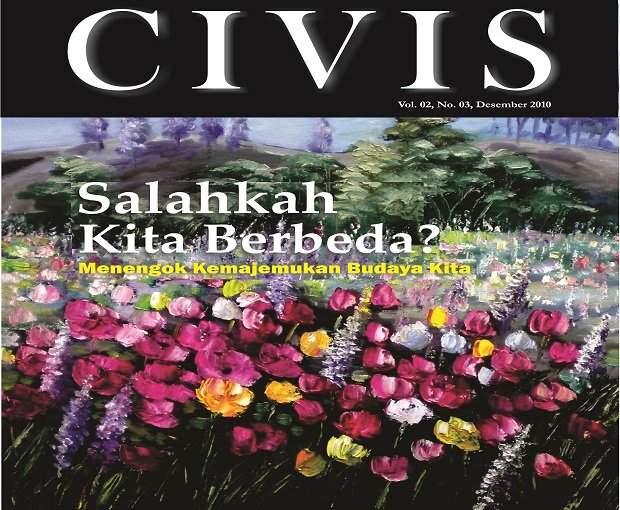
Civis Vol. 2, No. 3, Dec 2010
The existence of pluralism and attitudes toward respect for diversity in Indonesian archipelago have long attracted the attention of foreign explorers. The fertile Islands are blessed with a lot of commodities needed by the people of Europe, the Middle East, South Asia and China, which in turn birthed a cosmopolitan emporium. Merchants, carpenters, teachers, soldiers and dispersers of religion from various countries have chosen to live and multiply in this emerald country. In addition, the 17,000 islands in Indonesia are hosts to various tribes (1,128 distinct people groups, according to BPS survey in February 2010).
This article tries to give facts of diversity in this large canvas of Indonesian history. Pluralism is not foreign nor unknown to this nation’s past. However, this paper would also like to remind, that efforts to eliminate such diversity too often have appeared. Presentation of various historical data here wants to show, that diversity should be taken as grace, not as a frightening phenomenon, which can actually be managed for the progress of the nation.
China and Islam
As leaders of a maritime empire that lived on trade, the king and local authorities needed people who had expertise in business management. Thus, the presence of capable foreigners who intended to devote themselves among them were greeted warmly. Lodewyks, who participated in the first Dutch expedition to Banten, noted in 1596 that in the kingdom there were Chinese people who served the king and also became Muslim. Kyai Ngabehi Kaytsu and Kyai Ngabehi Cakradana were Chinese Muslims trade officials from Banten in the XVII century. Duke Bangil and Regent Tegal are second generation relatives of Han Siong Kong who was born in China (1673) and died in Lasem (1744). The office of Regent of Yogyakarta (1813-1831) at the time of Sultan Hamengku Buwono II, was chaired by Raden Tumenggung Setjadiningrat alias Tan Jin Sing (1760-1831).
Those Chinese who converted to Islam and their offspring were then referred to as the “Peranakan”. This term is used to distinguish them with the Chinese non-Muslims who themselves were called “Chinezen” by the Dutch. Many Peranakan lived in Batavia, Cirebon, Surakarta, Makassar, Sumenep and Maluku / Banda. In Batavia, since the Chinese Muslim population was quite a lot, then was appointed an officer to this community. Peranakan’s last captain was named Muhammad Japar (d. 1827). Historian Adolf Heuken showed many Chinese-founded mosques in Batavia, such as Kebon Jeruk, Angke, Hidayatullah and Krukut mosques. In Sumenep (Madura), Jami Mosque’s architect was Pia Lauw Ngo, a Chinese non-Muslim. As a token of his gratitude, Duke Sumenep granted the land to the west of the palace to Lauw and his family.
Interracial Marriage
The (male) migrants mostly arrived without a companion; they then perform mixed marriages with local women. A Freedom fighter from Banda (Maluku), who just passed away, Des Alwi Abubakar (1927-2010), is an example of “Indonesia Mini” which is built from diversity. In his memoir Friends and Exiles (2008), he wrote:
My grandfather was named Said Tjong Baadilla. His mother is a family member of the Tay clan, who was said to have descended from the remnants from the Ming Dynasty and who invaded Batavia in the mid 17th century and were exiled to Banda. His mother’s father was the leader of the Chinese community; one of whose daughters married a descendant of a Spaniard named Montanus. The other one married a Chinese named Nio Chiu and the third, my great grandmother, married Abdullah Baadilla. Baadilla is a name that is found in Spain and the Philippines, and thought to have come from Morocco.
The analysis above shows the triumph of hybridity in the spice islands. Mixing of blood between the various ethnic groups, as well as between newcomers and members of the local population is not uncommon in the past, and stories such as this appears also in various regions.
Kompas Daily Newspaper in its February 23, 2009 edition shows the figure of Yasir Ferry Ismatrada, a Lethek noodle entrepreneur in Bantul, Yogyakarta. This family business began when his grandfather who came from Hadramaut, met his grandmother who was ethnic Chinese. The grandmother who had the expertise of making noodles applied the skill to help the family economy. Now, this Arab-Chinese family’s products are quite known by the people of Yogyakarta.
Joint Struggle Against Colonizer
Dutch colonial rulers tried to prevent the occurrence of synergy between the various tribes that could undermine his power. Divisive tactic was partly successful, but there also existed many examples of cooperation between the various ethnic groups against the Dutch. In 1740-1743 Chinese and Javanese militia together took up arms to expel the Dutch. According Daradjadi’s During the War (2008), in terms of personnel and geographical area, the war was more extensive than the Diponegoro War (1825-1830). Unfortunately, divide et impera tactics succeeded in breaking the combined resistance.
Chinese people also gave support to the national movement. Kwee Kek Beng, Chief Editor of Sin Po (a popular Malay-language Chinese daily and magazine at the time), wrote that in the late 1920s, Bung Karno went to Sin Po for support. Keep in mind that the national anthem Indonesia Raya was first promoted in the weekly Sin Po, because WR Supratman was working for them at the time.
Chinese Indonesians contribution in the military field, among others, is represented by Navy Major John Lie (John Daniel Dharma). As a skipper, John Lie was entrusted by the government of the Republic of Indonesia to sell commodities in exchange for much-needed weapon in the fight against the Dutch. His are of operations was vast and included Manila, Penang, Bangkok, Rangoon, New Delhi and Singapore. Although Indonesia was strictly blockaded by the Dutch, John Lie nevertheless broke through the siege, and earned the nickname “The Last Skipper of the Republic”. Finally John Lie is recognized as a National Hero in 2009, in recognition of his extraordinary services for the Government of Indonesia.
Chinese women were also capable to be an inspiration for women of other ethnicities. One clear example is the testimony of our national hero, Raden Ajeng Kartini (1879-1904) in a letter dated June 17, 1902:
In the newspapers, I just read that some Chinese girls asked to be allowed to take the teacher test. Hurray! To progress! I am really excited about it! Chinese people are supposed to be very strict in maintaining the custom: we now see, that even the hardest and longest custom can be broken too!
I gain the enthusiasm and hope!
I really want to get acquainted with these daring Chinese children! I am eager to want to know their thoughts, ideals and their feelings, their souls!
Forever I want to have a Chinese friend! I really want to know the inner life of such Chinese girl! It must possess a lot of beauty!
It seems clear that their activities did not only resonate in their community only, but were able to penetrate the racial and cultural barriers, as well as encouraging Kartini to continue to pursue progress for the nation and her gender.
The attack on Pluralism
According to Steenbrink in Some Aspects About Islam in Indonesia (1984), along with the intensification of colonial penetration, since the eighteenth century several times VOC issued a ban on Chinese group to be converted to Islam, or to assimilate themselves with the indigenous population. To further tighten controls, marriages between Muslims and Chinese were also banned from the Netherlands in the XVIII century. Netherlands apparently afraid that both parties would join forces, and thus looked for ways to keep them separate.
Deepening involvement of the Chinese in economic problems of the everyday people of Java, particularly the collection of taxes from the toll booths and from the sale of opium in the nineteenth century, caused the Chinese to be blamed for the poverty of the people. So Prince Diponegoro announced that the Chinese wereone of the targets of his Holy War. They will be destroyed if they were not willing to embrace Islam, as recorded in the Annals of Diponegoro.
More specifically, Diponegoro made the association with Chinese women as the cause for his as well as his in-laws defeats. The night before the battle, they allegedly conducted a tryst involving a Chinese lady. Unable to accept defeat, they looked for scapegoats and the women were easily targeted. In Java Nusa: Cross-Cultural. Volume 2 Denys Lombard commented about this “completely racist idea” as follows:
Perhaps, even worse … was a dangerous ideology which began to be distributed by Diponegoro and his followers: that the Chinese were not just categorized as unbelievers, but followers of Diponegoro were also officially forbidden from marrying Chinese women or to take a Peranakan woman as a concubine.
Thus the ideals of mixed Chinese-Javanese marriage were destroyed. As told by Peter Carey in Chinese People, Bandar Toll, Opium and the Java War (2008), then had risen the myth that created in Java men the fear of marrying Chinese women, that the “ashes” of Chinese people are more dominant, so that later the mixed children would have more dominant Chinese features. Through surrounding environments and context such as these, more and more Chinese people were alienated as ‘foreigners’ (outsiders) and their vulnerable position as the ‘intermediary minority’ became further consolidated.
In the New Order, a “phantom” concept was created called SARA (short for Ethnic, Religious, Race, Groups) public discussions around which were declared taboo. Then came the pressure from the government to assimilate the Chinese, by forcing them to replace their original name into more common Indonesian names, and by banning indigenous celebrations of Chinese culture and language. The fall of New Order has opened the taps of diversity that had been shut. But the Reformation is still tainted by ethnic and religious conflict, as well as coercive efforts toward uniformity in the name of religion or ideology.
Closing
From the above, it can be seen that the atmosphere of pluralism has not always been breezy but on th econtrary is often under attack, both from the ruling regime and pressure groups. But history also shows that diversity never dies on this earth, because there are many community groups that fight for it consistently. The blending of the positive aspects of the cultures of various ethnic and tribal people, is realizing what was called by Eddie Lembong as “cross-pollination between cultures” (cross-cultural fertilization), which will eventually form a new, harmonious culture of Indonesia, one that is more advanced and more superior.
For Christians, in Luke 10: 36-37, Jesus asserted that the assessment of an individual is not based on his ethnicity, but based on his deeds. This is an important message for life in the multi-cultural society. In recent days the vision of multicultural education has begun to be pursued in high schools. It would be nice, if in-class explanations also presented examples from the past. History will always need to be revisited to be able to answer a variety of contemporary problems, including problems of national integration and multiculturalism. For this reason, opined Koentjaraningrat, the historical study of inter-ethnic relations will be very useful for this multi-ethnic state of Indonesia and has to be continuously voiced .**
Author
Didi Kwartanada is a historian and a Ph.D candidate from the National University of Singapore (NUS). Currently he is working as staff at the Nabil Foundation, Jakarta.
